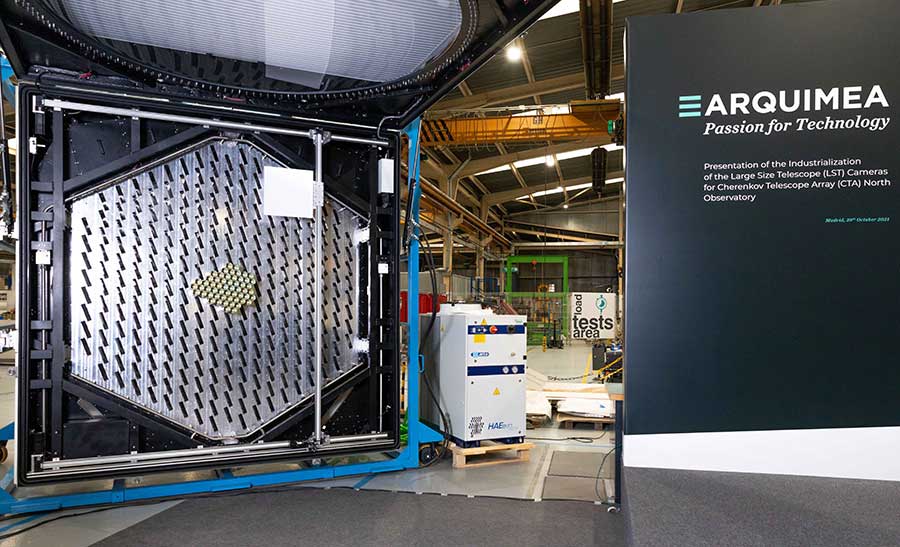- Sectors
- Aerospace & Defense
- Big science
- Fintech
- Insights

The Cherenkov Telescope Array (CTA) observatory is a high-technology international scientific project that aims to create a scientific facility, unique in the world, which will allow further study and knowledge of the universe through the interaction in the Earth’s atmosphere of gamma rays from distant phenomena produced in outer space.
The observatory intends to build one hundred Cherenkov-type telescopes at two locations: Roque de los Muchachos Observatory on the island of La Palma, Canary Islands (Spain), and in the Atacama Desert in Chile. The observatory will have three types of telescopes: large-sized telescopes (LST) with a diameter of 30 metres, medium-sized telescopes (MST) with a diameter of 12 metres and small-sized telescopes (SST) with a diameter of 4.3 metres. The project will create a global network of telescopes for the study of the universe.
The Cherenkov Telescope Array project involves an investment of over €300 million and the participation of over 1,400 scientists and engineers from 32 countries; Spanish institutions such as the Canary Islands Astrophysics Institute (IAC), the Centre for Energy, Environmental and Technological Research (CIEMAT), and the Institute for High Energy Physics (IFAE), play a fundamental role in the project.
Through the analysis of the electromagnetic phenomena produced in the atmosphere by gamma rays, scientists can collect data, study and analyse events in the universe that would otherwise be unidentifiable.
The most important component of the telescopes is their camera, capable of detecting high-energy radiation with unprecedented precision and a sensitivity ten times higher than that of the existing Cherenkov telescopes. The telescope network is able to orientate itself within seconds, and in a coordinated manner, to measure a particular event.
If all projections are met, the Cherenkov Telescope Array telescope network at the La Palma Observatory is expected to be operational from 2024 onwards.
The Cherenkov Telescope Array observatory aims to create a global network of hundreds of telescopes of different sizes. Each telescope must meet CTA’s scientific objectives and satisfy the observatory’s operational needs and comply with the highest quality and safety standards.
The challenge addressed by ARQUIMEA was to manufacture three cameras for the observatory’s Large-Sized Telescopes (LST) using a mass production system. Thanks to the industrialisation process, all the cameras will have the same specifications and characteristics and could be manufactured efficiently, at the right price and turnaround time.
Each camera has a surface area of 9 m², weighs two tonnes and contains 265 optical sensors (photomultipliers) that are responsible for producing the required resolution.
The greatest difficulty in a project of this nature is the engineering of diverse systems and their integration and verification throughout the entire manufacturing process. The cameras have over 5,000 different parts manufactured by a large number of suppliers in different countries. For example, the photomultipliers are produced in Japan. The manufacture of the structure, as well as the successful assembly, integration and testing of all the components, are the main challenges facing the camera production project.
Coordination between science and industry in order to achieve this goal has been a major challenge throughout all phases of the project.
The Canary Islands Astrophysics Institute (IAC), which is responsible for managing the infrastructure, conducted an international tender for the manufacture of the cameras, and ARQUIMEA was awarded the contract in 2020.
The company has extensive experience in the manufacture, assembly, integration and testing of key components for this type of infrastructure, and has participated in major astrophysics projects such as the Large Telescope in the Canary Islands, as well as in other projects in highly demanding sectors such as the aerospace industry.
The first camera that served as a prototype was manufactured by CIEMAT in 2018 and is currently operational at the Roque de los Muchachos Observatory on the island of La Palma. ARQUIMEA has worked in coordination with the IAC and CIEMAT to improve the design of the first camera and to manufacture the three new cameras.
The aim was to focus on a mass production approach, with a certified quality control system. Efficiency and proper planning helped to overcome difficulties such as the shortage of chips that affects many sectors.
Each 9 m2 camera has 265 multipliers and weighs two tonnes. The cameras are based on a modular design with all sensors and electronics on-board, ready to be installed on the carbon fibre arc of the telescope.
These cameras are an essential component of the telescopes, as they are responsible for collecting and analysing the data. The cameras will enable both the source of the gamma ray and its energy spectrum to be measured with very high precision.
The main components of the cameras are:
Mixed manufacturing and assembly techniques have been used in the industrialisation process, including precision machining, deep hole boring, sheet metal forming, TIG and MIG welding, vibration Stress Relief, NDT’s, riveting, bolting, bonding, sealing, handling and assembly of large components.
In addition to the above, different technologies have also been integrated, including: aluminium alloy structures, combined water-air active cooling, electrical mechanisms (shutter, target lens), hydraulic actuation, automation and sensing, hardware electronics, transport shock absorbers, among other technologies.